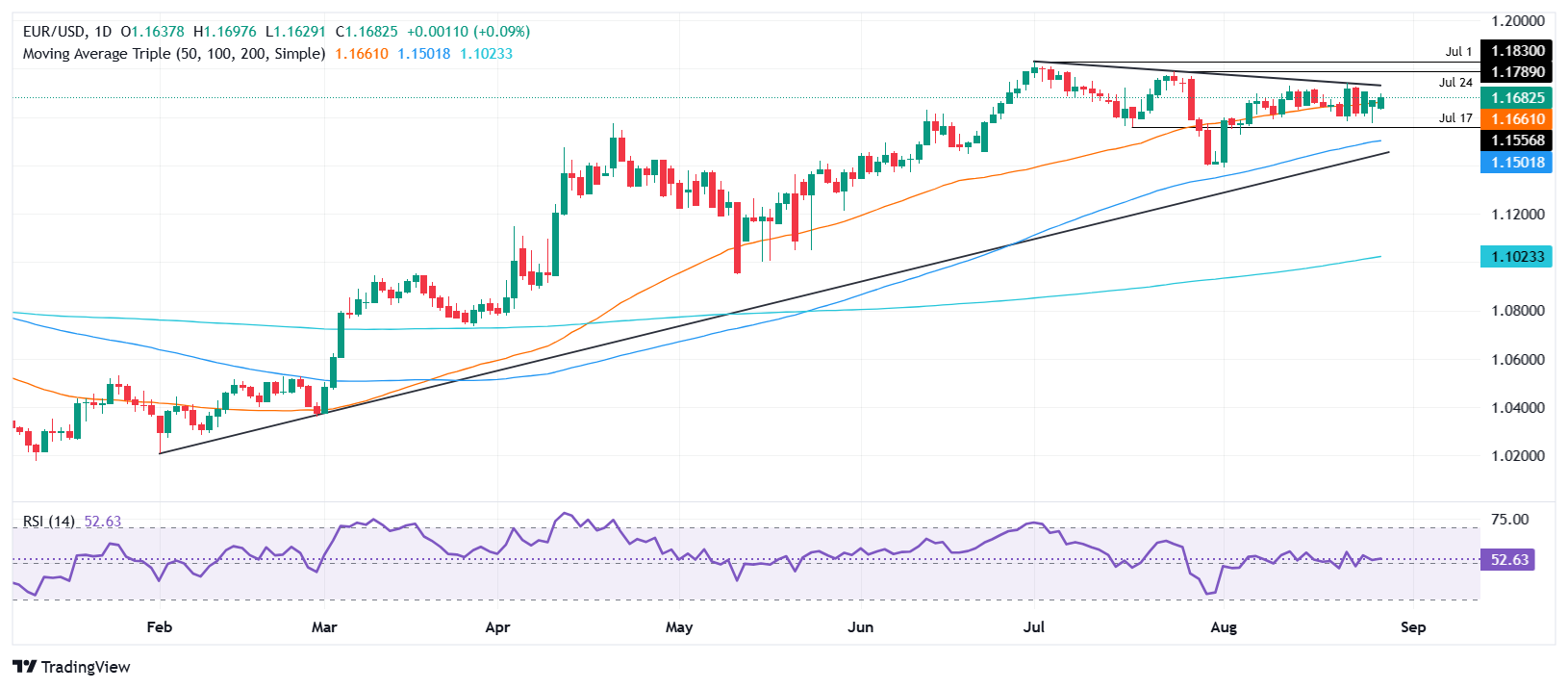EUR/USD edges higher as Fed turmoil and safe-haven flows pressure US Dollar

EUR/USD edges up late in the North American session on Thursday, as theUS Dollar(USD) fails to gain traction on upbeat US data, amid the ongoing conflict between US President Donald Trump andFederal Reserve(Fed) Governor Lisa Cook. At the time of writing, the pair trades at 1.1688, up 0.43%.
Traders remained hooked to the battle between the Fed and the White House as the latest Gross Domestic Product (GDP) figures and Initial Jobless Claims in the US showed that the economy is solid. Consequently, the Greenback depreciated for the third consecutive day as traders seeking safety bought the shared currencies, the Swiss Franc (CHF) and the Japanese Yen (JPY).
Despite this, the Euro’s advance might be short-lived, as French Prime Minister Bayrou called for a confidence vote amid an environment in which the country lacks a budget, increasing his chances of being sacked.
The European Union (EU) economic schedule featured the minutes of theEuropean Central Bank(ECB)'s last meeting, the August Economic Sentiment Indicator and Consumer Confidence for the same period.
The US economic schedule will feature on Friday, the release of the Fed’s preferred inflation gauge, the Core Personal Consumption Expenditures (PCE) Price Index.
Daily digest market movers: Traders ignore strong US GDP data, boosting the Euro
Technical outlook: EUR/USD poised to challenge 1.1700 in the near term
The EUR/USD uptrend remains intact, extending its gains beyond 1.1600 and reaching a three-day high near 1.1700. It is worth noting that the Relative Strength Index (RSI), which had turned bearish, bounced back into bullish territory, indicating that buyers are in control.
A daily close above 1.1700 would solidify the case for testing higher prices. The next area of interest would be 1.1742, the August 22 high, 1.1800, and the year-to-date (YTD) peak of 1.1829.
On the downside, a break below the 50-day SMA of 1.1658 will expose the 20-day SMA at 1.1645, followed by the 100-day SMA near 1.1506.
Euro FAQs
What is the Euro?
The Euro is the currency for the 19 European Union countries that belong to the Eurozone. It is the second most heavily traded currency in the world behind the US Dollar. In 2022, it accounted for 31% of all foreign exchange transactions, with an average daily turnover of over $2.2 trillion a day. EUR/USD is the most heavily traded currency pair in the world, accounting for an estimated 30% off all transactions, followed by EUR/JPY (4%), EUR/GBP (3%) and EUR/AUD (2%).
What is the ECB and how does it impact the Euro?
The European Central Bank (ECB) in Frankfurt, Germany, is the reserve bank for the Eurozone. The ECB sets interest rates and manages monetary policy. The ECB’s primary mandate is to maintain price stability, which means either controlling inflation or stimulating growth. Its primary tool is the raising or lowering of interest rates. Relatively high interest rates – or the expectation of higher rates – will usually benefit the Euro and vice versa. The ECB Governing Council makes monetary policy decisions at meetings held eight times a year. Decisions are made by heads of the Eurozone national banks and six permanent members, including the President of the ECB, Christine Lagarde.
How does inflation data impact the value of the Euro?
Eurozone inflation data, measured by the Harmonized Index of Consumer Prices (HICP), is an important econometric for the Euro. If inflation rises more than expected, especially if above the ECB’s 2% target, it obliges the ECB to raise interest rates to bring it back under control. Relatively high interest rates compared to its counterparts will usually benefit the Euro, as it makes the region more attractive as a place for global investors to park their money.
How does economic data influence the value of the Euro?
Data releases gauge the health of the economy and can impact on the Euro. Indicators such as GDP, Manufacturing and Services PMIs, employment, and consumer sentiment surveys can all influence the direction of the single currency. A strong economy is good for the Euro. Not only does it attract more foreign investment but it may encourage the ECB to put up interest rates, which will directly strengthen the Euro. Otherwise, if economic data is weak, the Euro is likely to fall. Economic data for the four largest economies in the euro area (Germany, France, Italy and Spain) are especially significant, as they account for 75% of the Eurozone’s economy.
How does the Trade Balance impact the Euro?









_300xx250.jpg)

0 댓글